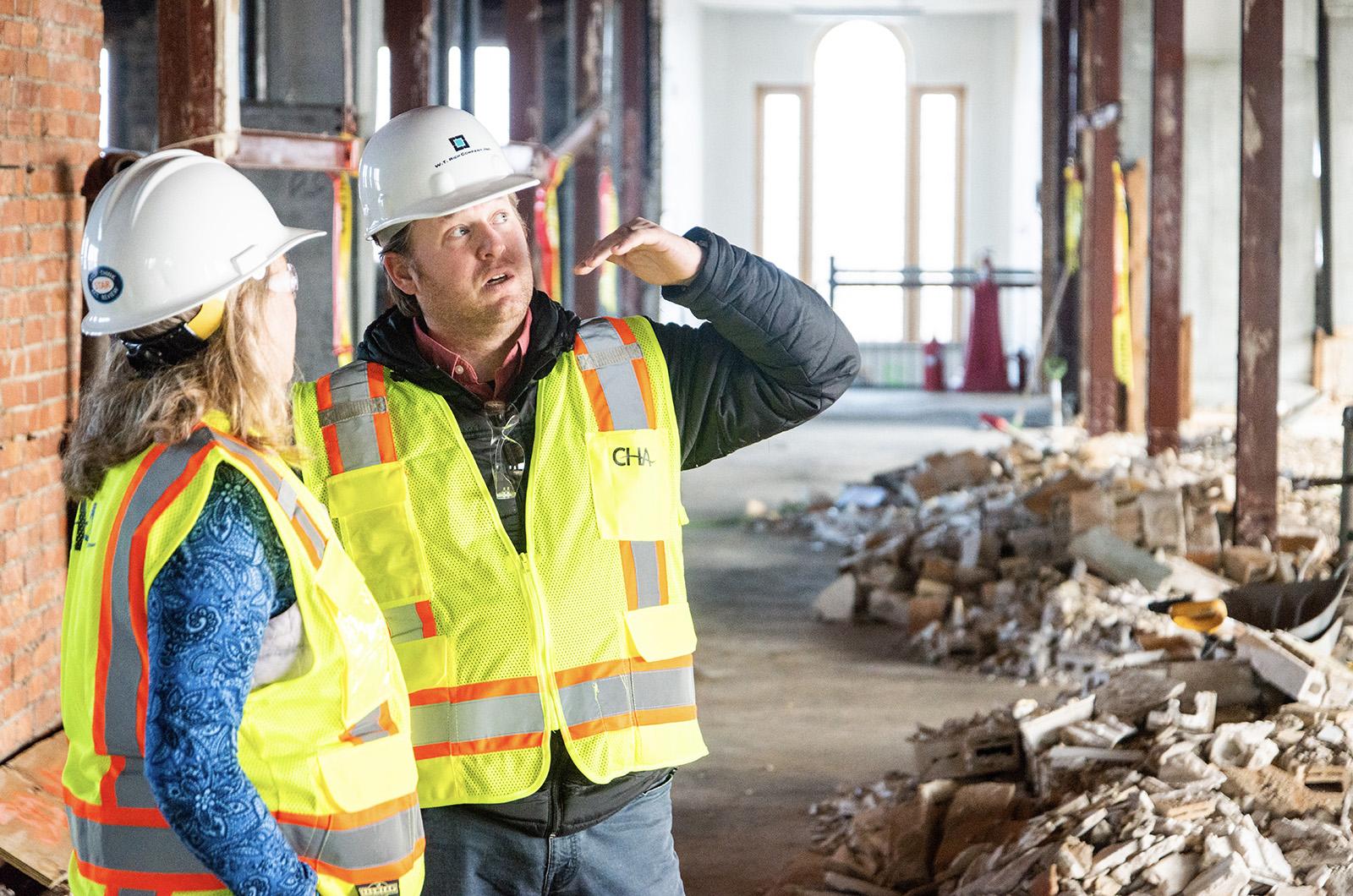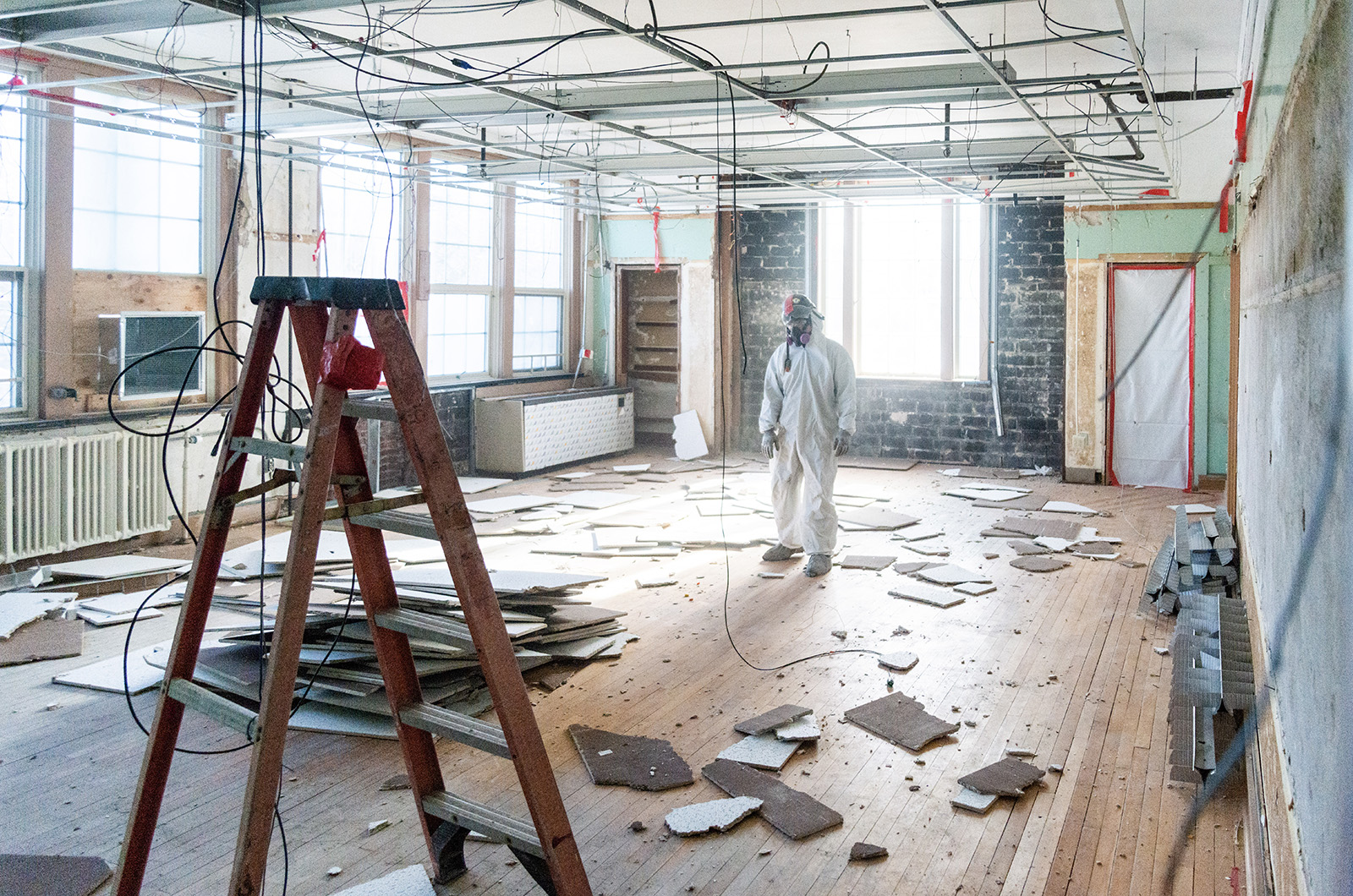Demolition inside the Tisbury School has cleared away nearly a century’s worth of accumulated renovations, revealing the original interior of a town landmark built on the eve of the Great Depression.
The 1929 school’s top level now stands open from end to end, flooded with light from banks of windows beneath a ceiling that vaults more than 15 feet from the rubble-carpeted floor. One side of the third floor is slated to become classrooms, while the media center will stretch along a windowed wall on the other side.
But this week, only structural supports and a soon-to-be-removed brick ventilator broke the sweep of space, with an open section of exterior wall providing a dizzying, gull’s-eye view of the campus below.
The third floor offers a preview of what’s to come for the first and second floors, Tisbury School building committee chair Mike Watts told the Gazette during a tour of the construction site this week with school committee chair Amy Houghton, senior project supervisor Steve Brenner of W.T. Rich Co., owner’s project manager Michael Owen of CHA, and architect Chris Blessen.
On the school’s second floor, workers have continued removing interior walls, dropped ceilings, lighting fixtures and piping, separating the materials for recycling and disposal.
Mr. Brenner credited the orderly demolition to West Wareham-based Costello Dismantling, one of several local and regional contractors he’s working with that also include Cottle’s for lumber and Goodale’s for cement.
“We’re actively trying to use the resources of the Island to benefit the residents,” he said.
The project has taken a long journey to this first step, with a facility needs committee first formed in 2011. CHA Consulting, formerly known as Daedalus, began working with the town as owner’s project manager in 2016, the year Tisbury was provisionally accepted into a state-funded school building program that would have provided about $14 million of the estimated $47 million total cost at the time to build an all-new school.
In that scenario, the existing Tisbury School would have been torn down after the new facility was built nearby. But the plan collapsed at the ballot box in 2018, when a narrow majority of Tisbury voters opposed a borrowing measure for the proposed construction and demolition that had previously passed town meeting.
The Tisbury school building committee regrouped with a new plan to preserve the old structure while updating it to meet the needs of a 21st-century educational program. In the spring of 2022, voters approved a $55 million borrowing measure for a project designed by Tappé Architects of Boston — an expectation that was soon shredded by inflation.
Now pegged at $81 million — with no state match available — the project received a $26 million borrowing boost at a special election last September. Once the funding was approved, the old gym was removed and some site work began, but contractors weren’t able to start inside until after Thanksgiving, when students and teachers finally moved into a modular temporary school on the building’s eastern side.
Tisbury has contracted W.T. Rich as construction manager at risk, an industry term that essentially means the company must absorb costs above a guaranteed level — in this case, the $81 million total that town voters have approved.
But the project’s most significant cost overrun so far has been for something outside of Mr. Brenner’s control. Insurance for the school while it’s under construction has nearly tripled from an original estimate of $310,000 to $882,944.96.
Insurance companies — including Martha’s Vineyard Insurance Agency, which holds the school’s policy — have adjusted their underwriting and premium structures upward in response to massive payouts for catastrophic damages elsewhere, Mr. Owen said at last week’s joint meeting of the school committee and school building committee.
A second factor behind the skyrocketing insurance cost is the old school itself.
“The 1929 edition has a significant amount of wood framing in it, i.e. ceiling and joist structure,” Mr. Owen told committee members last week. “That’s the reason we have that higher premium. And the town’s broker went to many, many companies and this is the best [rate] they could get.”
During the tour on Tuesday, the first floor of the school was still sealed off for hazardous materials removal, which has already been completed in the rest of the building, Mr. Brenner said.
As was common in much of the 20th century construction industry, asbestos was widely used at the school, he added — even in the mastic adhesive used to glue chalkboards to classroom walls. Some Tisbury schoolrooms have already had some abatement, after the discovery of both asbestos and lead paint led the school to relocate its top three grades to the Martha’s Vineyard Regional High School in Oak Bluffs for half of the 2019-2020 school year.
The current project will strip these rooms to their bones as well, before rebuilding a new school inside the 1929 envelope with a brand-new gym addition outside.
The project is slated for completion in the fall of 2024, and the work has been proceeding on schedule, Mr. Brenner said, in part because he and project engineer Anthony Visconti have each moved to the Vineyard for the duration and W.T. Rich has been putting other workers up on the Island during the work week. More workers are likely to become daily commuters over the summer, when accommodations are fewer and more expensive and the workforce is larger.
About 30 or 40 people are presently working at the site, Mr. Brenner said, with about 100 to 120 expected to be on the job at its peak. Weather is no obstacle to the timeline, he said, because the work can take place under almost any conditions.
“The only time it would stop us is if there’s severe lightning, because of the height of the equipment,” Mr. Brenner said, as heavy machinery rumbled across the packed dirt where the old school gym was removed last fall.
Some six or seven vertical feet of that dirt will be gone by winter’s end, when construction is set to begin on a new gymnasium located at the same level as the school parking lot, he said.
All hazardous materials from the school are segregated, labeled and sealed in a container for disposal off-Island, Mr. Brenner said, with a third-party hygienist monitoring the removal process and testing the school to certify that no threat remains.
More information about the building and renovation project is posted at tisbury-school-project.com.









Comments (2)
Comments
Comment policy »